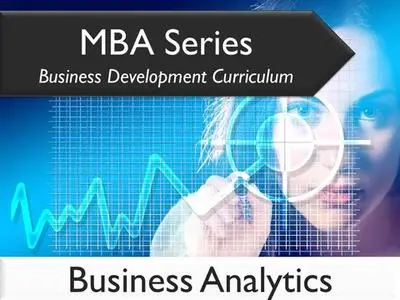
MBA Series Business Development Curriculum: Business Analytics
MP4 | Video: AVC 1280x720 | Audio: AAC 44KHz 2ch | Duration: 3 Hours 50M | 735 MB
Genre: eLearning | Language: English
Introducing Analytics. This first topic in the business analytics course introduces you to the world of analytics. Become equipped to explain what analytics is, why analytics is so important, and where analytics is used.
Know the difference between analysis and analytics. Be able to explain the various types of analytics, including descriptive analytics, diagnostic analytics, predictive analytics, and prescriptive analytics.
Analytics Applications and Methods. This second topic in the business analytics course explains the various analytics tools. Become equipped to explain the features and functionality of Microsoft Excel, Tableau, and Google Analytics. Know the use cases for analytics. Be able to summarize the various statistical methods for decision making, including optimization techniques, advanced statistics, data mining, predictive modeling, time series forecasting, and machine learning. Apply marketing and customer relationship management analytics.
Marketing and Customer Relationship Management Analytics Case Study. This third topic in the business analytics course provides a use case (Netflix) for marketing and customer relationship management analytics. Apply best practices in marketing analytics by ensuring high quality data, getting real time insights, providing proper training and support, and automating processes. Know the key components of financial analytics including predictive sales analytics, client profitability analytics, product profitability analytics, cash flow analytics, and value driven analytics.
Optimization Techniques in Analytics. This fourth topic in the business analytics course covers analytics optimization techniques. Become equipped to explain the various optimization techniques and the components of these techniques (decision variables, constraints, and objective functions). Know the vehicle routing problem. Be able to explain the various optimization techniques, including simple linear regression, support vector machines, time series analysis, reinforcement learning, neural networks, and K-means clustering. Apply simple linear regression.
K-means Clustering in Analytics. This fifth topic in the business analytics course covers K-means clustering in detail.
Advanced Statistics. This sixth topic in the business analytics course covers advanced statistics. Become equipped to explain statistics, and the various statistics techniques of regression analysis, ANOVA, factor analysis, cluster analysis, resampling methods, and logistic regression.
ANOVA Statistics. This seventh topic in the business analytics course goes into detail on the ANOVA statistics technique.
Data Mining. This eighth topic in the business analytics course covers data mining. Become equipped to explain data mining and the steps involved in the data mining process (business understanding, data understanding, data preparation, data modeling, data evaluation, and data deployment). Know the most popular data modeling techniques of classification, clustering, regression, outlier analysis, sequential patterns, prediction, and association. See how the techniques are applied in Tableau.
Predictive Modeling. This ninth topic in the business analytics course covers predictive modeling. Become equipped to explain predictive modeling and the predictive modeling techniques of logistic regression, neural networks, decision trees, and ordinary least square. See how the techniques are applied in Tableau and Microsoft Excel.
Time Series. This tenth topic in the business analytics course covers time series. Become equipped to explain time series, components of time series, and use cases of time series. Know the objectives of time series including providing compact descriptions of data, portraying relationships with other variables, predicting future values, and identifying the nature and phenomena of the observations. Apply the various time series techniques of simple moving average, exponential smoothing, and Holt's method. See how the techniques are applied in Microsoft Excel.
Machine Learning. This 11th topic in the business analytics course covers machine learning. Become equipped to explain machine learning, machine learning use cases (financial services, data analytics, marketing and sales, prediction, virtual process assistant, and healthcare), and the machine learning process. See how the regression model can be applied in Microsoft Excel.
Marketing Analytics. This 12th topic in the business analytics course covers marketing analytics. Become equipped to explain the components of marketing analytics. See how the techniques are applied in Tableau and Microsoft Excel.
Retail Analytics. This 13th topic in the business analytics course covers retail analytics. Become equipped to explain the four types of retail analytics. See how the techniques are applied in Tableau and Microsoft Excel.
Finance and Risk Analytics. This 14th topic in the business analytics course covers finance and risk analytics including credit risk, market risk, liquidity risk, and operational risk. Become equipped to explain the four types of retail analytics. Apply measures to calculate risk including project profitability ratios, debt ratios, break even analytics, liquidity ratios, operating profit ratios, business risk ratios, turnover ratios, scenario analysis, and valuation analysis.
Finance and Risk Analytics Case Study. This 15th topic in the business analytics course details a financial and risk analytics case study. Become equipped to explain finance and risk analytics by studying reports such as the profit and loss statement, balance sheet, cash flow statement, and ratio analysis. Apply break even analysis.
Web and Social Media Analytics. This 16th topic in the business analytics course covers web and social media analytics. Become equipped to explain web analytics, the tools to record website data, and how web analytics works through a Google Analytics case study.
Supply Chain and Logistics Analytics. This 17th topic in the business analytics course covers supply chain and logistics analytics. Become equipped to explain supply chain and logistics analytics and work through a Tableau case study.
Analytics Key Messages. This 18th topic in the business analytics course summarizes the course and provides the key messages.
DOWNLOAD
uploadgig
https://uploadgig.com/file/download/d1beE267eac6a14f/2x6cdKKl_MBASeriesBusinessDevelopmentCurriculumBusinessAnalytics.part1.rar
https://uploadgig.com/file/download/9Da539d59Cd12854/2x6cdKKl_MBASeriesBusinessDevelopmentCurriculumBusinessAnalytics.part2.rar
https://uploadgig.com/file/download/58f0b3495BA59781/2x6cdKKl_MBASeriesBusinessDevelopmentCurriculumBusinessAnalytics.part3.rar
rapidgator
https://rapidgator.net/file/d800519f6aa79acf7f8cf53d65c633ad/2x6cdKKl_MBASeriesBusinessDevelopmentCurriculumBusinessAnalytics.part1.rar
https://rapidgator.net/file/3294f6386d2b7490f001d9e796f8e5f0/2x6cdKKl_MBASeriesBusinessDevelopmentCurriculumBusinessAnalytics.part2.rar
https://rapidgator.net/file/2834b15eac2b795ca458021761c0a85c/2x6cdKKl_MBASeriesBusinessDevelopmentCurriculumBusinessAnalytics.part3.rar
nitroflare
http://nitroflare.com/view/0A62AF3CB0CFDA1/2x6cdKKl_MBASeriesBusinessDevelopmentCurriculumBusinessAnalytics.part1.rar
http://nitroflare.com/view/617D73015B3F83A/2x6cdKKl_MBASeriesBusinessDevelopmentCurriculumBusinessAnalytics.part2.rar
http://nitroflare.com/view/80FD5102A9B284B/2x6cdKKl_MBASeriesBusinessDevelopmentCurriculumBusinessAnalytics.part3.rar

